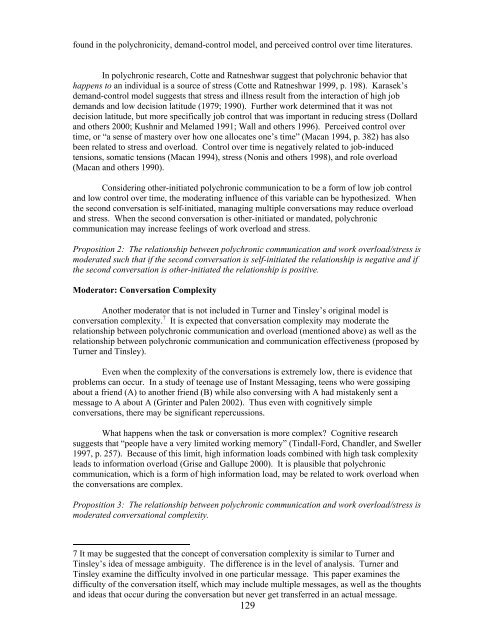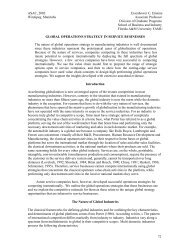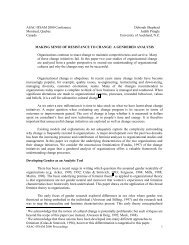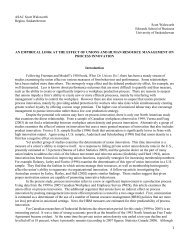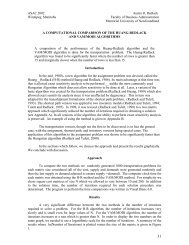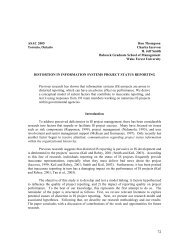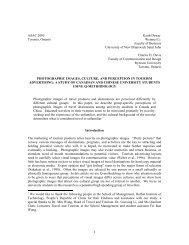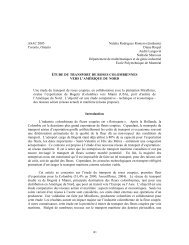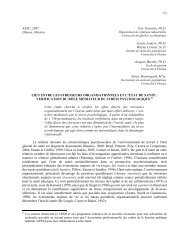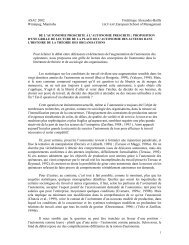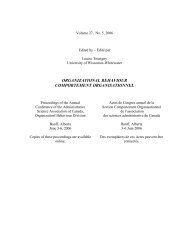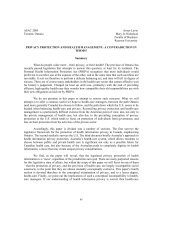Consequence: Impact on Work Overload and Stress 5Human-computer interaction researchers have noted that “[t]echnology has allowed moreand more information and people to reach us than ever before” (Hudson and others 2002, p. 97).As a result, “individuals feel overwhelmed” (p. 97). Thus, it may be hypothesized thatpolychronic communication (as a result of more people being able to reach us) leads to anincrease of work overload and stress. Support for this hypothesis is evident in a qualitative studyby Cotte and Ratneshwar where one polychronic worker noted, “I don’t know if I would take [thetasks] on all at once but I might … that’s why I have stomach problems, because I’m so worriedabout getting things done” (1999, p. 195). This positive relationship between workingpolychronically and overload is further supported by a study of police radio dispatchers.Dispatchers who simultaneously completed more than one task reported higher levels of workoverload (Kirmeyer 1988). Thus, an increase in polychronic communication may lead toincreased feelings of stress and work overload.Other findings, however, demonstrate that polychronicity actually decreases workoverload and stress. Kaufman and colleagues (1991) suggested that individuals may usepolychronic behavior as a means of reducing work overload by simultaneously satisfying diversedemands. A significant negative relationship between polychronic time orientation and overloadwas found in their study. 6 In a survey of university faculty members, job-induced stress waspositively correlated with monochronic, rather than polychronic, behavior (Frei, Racicot, andTravagline 1999). Still other researchers found that polychronicity was not significantly relatedto either work overload (Benabou 1999) or stress (Conte, Rizzuto, and Steiner 1999). It isapparent that the existing research linking polychronicity to work overload and stress isequivocal, alternately suggesting a positive, negative, or non-existent relationship. Whileevidence would suggest that there is some type of relationship between these two variables (seeProposition 1 below), ambiguity of the direction of the relationship would suggest the existenceof moderating variables.Proposition 1: There is a significant relationship between polychronic communication and workoverload/stress.Moderator: Self/other initiatedThe existing model does not address the fact that the polychronic communication can beeither self- or other-initiated. For example, an individual already in a conversation can initiate asecond conversation (the call center employee in Figure 1a or an employee checking email whileon a conference call), or have a second conversation thrust upon them (the manager in theboardroom meeting in Figure 1b). Persing (1999) examined this concept in terms of personalagency or the ability to determine your own actions. Those who behave polychronically do notalways do so of their own accord (self-initiated) but rather have the behavior thrust upon them ormandated by others (other-initiated). In conversations with engineers in an intellectuallyintensive environment, strong resistance to mandated polychronicity was noted (Persing 1999).Whether the communication is self or other-initiated may moderate the relationshipbetween polychronic communication and work overload/stress. Support for this proposition is5 Grise and Gallupe (2000) suggest that it is difficult to measure overload directly and soresearchers often identify overload by its effects. For this reason, overload and stress arediscussed together.6 Kaufman and colleagues (1991) actually related polychronicity to role overload, which is aconflict that is created when different roles have competing demands on an individual’s time.Since one job in an organization may include many roles, role overload is discussed in terms ofgeneral work overload.128
found in the polychronicity, demand-control model, and perceived control over time literatures.In polychronic research, Cotte and Ratneshwar suggest that polychronic behavior thathappens to an individual is a source of stress (Cotte and Ratneshwar 1999, p. 198). Karasek’sdemand-control model suggests that stress and illness result from the interaction of high jobdemands and low decision latitude (1979; 1990). Further work determined that it was notdecision latitude, but more specifically job control that was important in reducing stress (Dollardand others 2000; Kushnir and Melamed 1991; Wall and others 1996). Perceived control overtime, or “a sense of mastery over how one allocates one’s time” (Macan 1994, p. 382) has alsobeen related to stress and overload. Control over time is negatively related to job-inducedtensions, somatic tensions (Macan 1994), stress (Nonis and others 1998), and role overload(Macan and others 1990).Considering other-initiated polychronic communication to be a form of low job controland low control over time, the moderating influence of this variable can be hypothesized. Whenthe second conversation is self-initiated, managing multiple conversations may reduce overloadand stress. When the second conversation is other-initiated or mandated, polychroniccommunication may increase feelings of work overload and stress.Proposition 2: The relationship between polychronic communication and work overload/stress ismoderated such that if the second conversation is self-initiated the relationship is negative and ifthe second conversation is other-initiated the relationship is positive.Moderator: Conversation ComplexityAnother moderator that is not included in Turner and Tinsley’s original model isconversation complexity. 7 It is expected that conversation complexity may moderate therelationship between polychronic communication and overload (mentioned above) as well as therelationship between polychronic communication and communication effectiveness (proposed byTurner and Tinsley).Even when the complexity of the conversations is extremely low, there is evidence thatproblems can occur. In a study of teenage use of Instant Messaging, teens who were gossipingabout a friend (A) to another friend (B) while also conversing with A had mistakenly sent amessage to A about A (Grinter and Palen 2002). Thus even with cognitively simpleconversations, there may be significant repercussions.What happens when the task or conversation is more complex? Cognitive researchsuggests that “people have a very limited working memory” (Tindall-Ford, Chandler, and Sweller1997, p. 257). Because of this limit, high information loads combined with high task complexityleads to information overload (Grise and Gallupe 2000). It is plausible that polychroniccommunication, which is a form of high information load, may be related to work overload whenthe conversations are complex.Proposition 3: The relationship between polychronic communication and work overload/stress ismoderated conversational complexity.7 It may be suggested that the concept of conversation complexity is similar to Turner andTinsley’s idea of message ambiguity. The difference is in the level of analysis. Turner andTinsley examine the difficulty involved in one particular message. This paper examines thedifficulty of the conversation itself, which may include multiple messages, as well as the thoughtsand ideas that occur during the conversation but never get transferred in an actual message.129
- Page 1 and 2:
Volume 24, No. 5, 2003Edited by/Éd
- Page 4 and 5:
Pursey HeugensGreg IrvingRoderick I
- Page 6 and 7:
TABLE OF CONTENTS - TABLE DES MATI
- Page 8 and 9:
study of power displays in mixed-ge
- Page 10 and 11:
on expectations and behaviour (Berg
- Page 12 and 13:
TaskThis study required the use of
- Page 14 and 15:
Task-Gender (male-stereotyped or fe
- Page 16 and 17:
It is important to understand the s
- Page 18 and 19:
Crown, C.L. & Cummins, D.A. (1998).
- Page 20 and 21:
Smith-Lovin, L., & Brody, C. (1989)
- Page 22 and 23:
Table 2Summary of Descriptive Stati
- Page 24 and 25:
Table 4Summary of Interaction of Ge
- Page 26 and 27:
ASAC 2003Halifax, Nova ScotiaIain L
- Page 28 and 29:
the interrelationships among the MB
- Page 30 and 31:
studies (Friedman and Sarros, 1989;
- Page 32 and 33:
This study demonstrated that emotio
- Page 34 and 35:
Anxiety, Stress and Coping, in pres
- Page 36 and 37:
Washington, DC: Taylor and Francis,
- Page 38 and 39:
Table 2Overall Goodness-of-Fit Indi
- Page 40 and 41:
ζ 3Depersonalizationη 3β 3,1 (+)
- Page 42 and 43:
ASAC 2003Halifax, Nova ScotiaWendy
- Page 44 and 45:
views independently, gave rise to S
- Page 46 and 47:
track assistant, associate, and ful
- Page 48 and 49:
ole conflict are positively related
- Page 50 and 51:
Table 3. Regression of climate and
- Page 52 and 53:
interests.We speculate the null eff
- Page 54 and 55:
DOOP and short for DOOP scales,”
- Page 56 and 57:
Pelled, L. H., “Demographic diver
- Page 58 and 59:
esulting increase in discretion ove
- Page 60 and 61:
al., 1995). However, the distinctio
- Page 62 and 63:
ise to strong pressures for conform
- Page 64 and 65:
presented with a complete list of a
- Page 66 and 67:
Table 3QAP Regression Coefficients
- Page 68 and 69:
ConclusionResearchers of social inf
- Page 70 and 71:
suggestions for further research.
- Page 72 and 73:
performing on the job.” Presumabl
- Page 74 and 75:
positively related to performance i
- Page 76 and 77:
proposed hypotheses were supported.
- Page 78 and 79:
ConclusionThis research has made se
- Page 80 and 81:
Be more enthusiastic and exert extr
- Page 82 and 83:
Table 2Correlations Among the Laten
- Page 84 and 85: performance expectations on feedbac
- Page 86 and 87: changements qui s’opèrent dans l
- Page 88 and 89: structures, politiques, systèmes,
- Page 90 and 91: comportements liés à la communica
- Page 92 and 93: Tableau 2Échelles de mesure de la
- Page 94 and 95: prédiction des compétences clés
- Page 96 and 97: organisation n’est pas uniforme e
- Page 98 and 99: complètement ce construit. Ces cha
- Page 100 and 101: Wagner, R.K. and Sternberg, R.J. (1
- Page 102 and 103: What is a toxin handler?In two arti
- Page 104 and 105: potentially limited scope and conte
- Page 106 and 107: work role demands. In this survey,
- Page 108 and 109: The three factors in this rotated f
- Page 110 and 111: and service orientation, the abilit
- Page 112 and 113: ASAC 2003Halifax, Nova ScotiaLisa M
- Page 114 and 115: self-appraisal group reacted more n
- Page 116 and 117: effect of voice are the value-expre
- Page 118 and 119: “Strongly Disagree” to “Stron
- Page 120 and 121: esults suggest that incorporating s
- Page 122 and 123: Personality and Social Psychology,
- Page 124 and 125: Table 1Means, Standard Deviations,
- Page 126 and 127: Table 3Test of the Mediating Role o
- Page 128 and 129: ASAC 2003Halifax, Nova ScotiaAnn Fr
- Page 130 and 131: individual level, polychronicity is
- Page 132 and 133: construct.Drawing on computer-media
- Page 136 and 137: Conversation complexity may also mo
- Page 138: Implications for practiceFuture res
- Page 141 and 142: ReferencesAncona, D.G., Goodman, P.
- Page 143 and 144: no. 3 (1994): 381-391.Macan, T.H.,
- Page 145 and 146: ASAC 2003Halifax, Nova ScotiaIan R.
- Page 147 and 148: Assessing Measures: Affective Commi
- Page 149 and 150: implications of psychological contr
- Page 151 and 152: commitment, affective commitment, c
- Page 153 and 154: Motivational Process Variables. Amo
- Page 155 and 156: DiscussionThe main purpose of this
- Page 157 and 158: approaches zero. In the present stu
- Page 159 and 160: Extension and test of a three-compo
- Page 162 and 163: Table 1Descriptive Statistics and Z
- Page 164 and 165: Table 3Standardized Factor Loadings
- Page 166 and 167: Table 5Hierarchical Regression Anal
- Page 168 and 169: ASAC 2003Halifax, Nova ScotiaJoan F
- Page 170 and 171: ASAC 2003Halifax, Nova ScotiaArla D
- Page 172 and 173: ASAC 2003Halifax, Nova ScotiaIvy Ky
- Page 174: ASAC 2003Halifax, Nova ScotiaNina D


